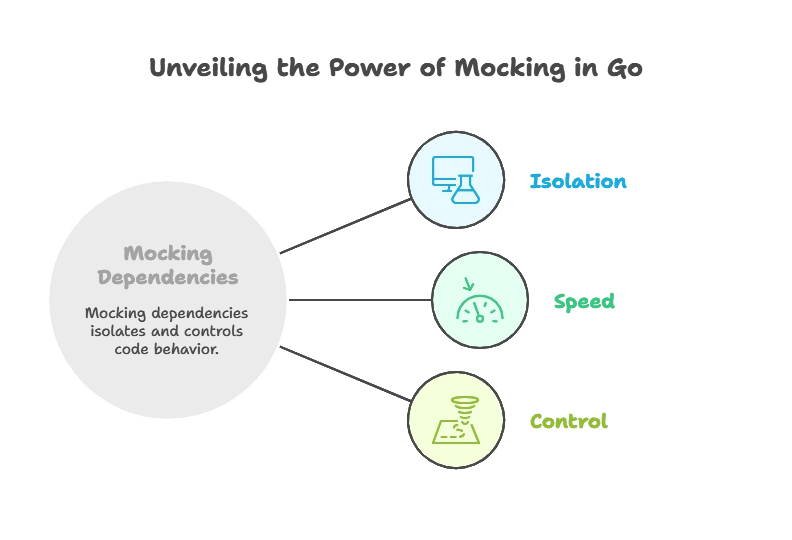Mocking Dependencies in Go
Mocking dependencies is a crucial aspect of writing effective tests in Go. Dependencies are external components or services that a piece of code relies on, such as databases, APIs, or external libraries. Mocking allows us to isolate the code under test from its dependencies, ensuring that tests are reliable, deterministic, and independent of external factors. In this chapter, we'll explore the fundamentals of mocking dependencies in Go, from basic concepts to advanced techniques.
Understanding Dependencies in Go
Before diving into mocking, it’s essential to understand the concept of dependencies in Go. Dependencies are external resources or components that a piece of code relies on to function correctly. These can include database connections, HTTP clients, file systems, or even other packages within the same project.
Why Mock Dependencies?
Mocking dependencies is necessary for several reasons:
- Isolation: By mocking dependencies, we can isolate the code under test from external factors, ensuring that tests are predictable and independent.
- Speed: Mocking allows tests to run quickly by avoiding the need to interact with real external resources, such as databases or APIs.
- Control: Mocks provide fine-grained control over the behavior of dependencies, allowing us to simulate various scenarios and edge cases during testing.

Basic Mocking with Interfaces
In Go, interfaces play a crucial role in enabling mocking. By defining interfaces for dependencies, we can easily create mock implementations for testing purposes.
Basic Mocking with Interfaces
type Database interface {
Save(data []byte) error
}
type MockDatabase struct {
SaveFunc func(data []byte) error
}
func (m *MockDatabase) Save(data []byte) error {
return m.SaveFunc(data)
}
func TestSaveData(t *testing.T) {
mockDB := &MockDatabase{
SaveFunc: func(data []byte) error {
// Mock implementation
return nil
},
}
service := NewService(mockDB)
// Test logic using the mocked database
}
In this example, we define a mock implementation of a database interface to simulate database interactions during testing.
Using Dependency Injection
Dependency injection is a design pattern where dependencies are passed as parameters to a function or struct rather than being hardcoded. This pattern facilitates mocking by allowing us to inject mock dependencies during testing.
Using Dependency Injection
type Service struct {
DB Database
}
func (s *Service) SaveData(data []byte) error {
return s.DB.Save(data)
}
func TestSaveData(t *testing.T) {
mockDB := &MockDatabase{
SaveFunc: func(data []byte) error {
// Mock implementation
return nil
},
}
service := &Service{DB: mockDB}
// Test logic using the mocked database
}
In this example, we inject a mock database dependency into a service struct during testing.
Advanced Mocking Techniques
Advanced mocking techniques go beyond simple substitution of dependencies with mocks. They involve verifying interactions, checking internal states, and dynamically generating mocks based on specific behaviors or expectations.
Behavior Verification
Behavior verification focuses on ensuring that the code under test interacts with its dependencies correctly. Instead of just checking the output of the code, behavior verification verifies that the correct methods are called on the dependencies with the expected parameters.
Example: Behavior Verification
type EmailSender interface {
SendEmail(to, subject, body string) error
}
type UserManager struct {
emailSender EmailSender
}
func (um *UserManager) RegisterUser(email string) error {
// Register user logic
if err := um.emailSender.SendEmail(email, "Welcome!", "Welcome to our platform!"); err != nil {
return err
}
return nil
}
func TestUserManager_RegisterUser(t *testing.T) {
mockEmailSender := &MockEmailSender{}
mockEmailSender.On("SendEmail", "test@example.com", "Welcome!", "Welcome to our platform!").Return(nil)
userManager := &UserManager{emailSender: mockEmailSender}
err := userManager.RegisterUser("test@example.com")
if err != nil {
t.Errorf("unexpected error: %v", err)
}
mockEmailSender.AssertExpectations(t)
}
In this example, we use a mocking library (like testify/mock) to create a mock implementation of the EmailSender interface. We then set expectations on the mock, specifying that the SendEmail method should be called with specific arguments. Finally, we verify that the expectations were met using AssertExpectations.
State Verification
State verification involves checking the internal state of the code under test after it interacts with dependencies. This ensures that the code behaves as expected and produces the correct side effects or updates its internal state appropriately.
Example:State Verification
type Counter struct {
value int
}
func (c *Counter) Increment() {
c.value++
}
func TestCounter_Increment(t *testing.T) {
counter := &Counter{}
counter.Increment()
if counter.value != 1 {
t.Errorf("expected counter value to be 1, got %d", counter.value)
}
}
In this example, we test the Increment method of a Counter struct by verifying its internal state (the value field) after calling the method.
Dynamic Mocking
Dynamic mocking involves generating mock implementations dynamically based on predefined behaviors or expectations. This allows for more flexible and customizable mocks that can adapt to different scenarios during testing.
Example: Dynamic Mocking
type PaymentGateway interface {
Charge(amount float64) error
}
func ProcessPayment(amount float64, gateway PaymentGateway) error {
return gateway.Charge(amount)
}
func TestProcessPayment(t *testing.T) {
mockGateway := &MockPaymentGateway{}
mockGateway.On("Charge", 100.0).Return(nil)
err := ProcessPayment(100.0, mockGateway)
if err != nil {
t.Errorf("unexpected error: %v", err)
}
mockGateway.AssertExpectations(t)
}
In this example, we dynamically generate a mock implementation of the PaymentGateway interface with predefined behavior using a mocking library. We set expectations on the mock for a specific charge amount and verify that the code under test interacts with the mock as expected.
Mocking dependencies is a vital skill for writing robust and reliable tests in Go. By isolating the code under test from its dependencies, we can ensure that tests are predictable, fast, and independent of external factors. Understanding the fundamentals of mocking, including interfaces, dependency injection, and advanced techniques, empowers developers to write comprehensive test suites that validate their code thoroughly. Happy coding !❤️
